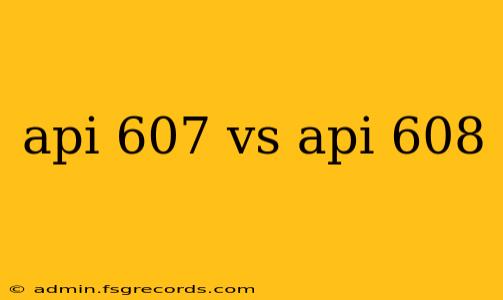Selecting the right valve for a refinery or petrochemical plant is critical for safety, efficiency, and regulatory compliance. Two standards frequently considered are API 607 and API 608, both covering valves intended for severe service applications. However, they address different valve types and design considerations. Understanding their distinctions is crucial for engineers and procurement professionals.
Key Differences Between API 607 and API 608
The primary difference lies in the valve types each standard covers:
-
API 607: Covers the design, testing, and inspection of fire-safe valves. These valves are specifically designed to maintain their sealing integrity even in the event of a fire. This is crucial for preventing leaks and explosions in hazardous environments.
-
API 608: Covers the design, testing, and inspection of ball valves for severe service applications. While fire safety can be incorporated, it's not the primary focus of this standard. Instead, API 608 emphasizes the performance and reliability of ball valves under extreme operating conditions.
Here's a breakdown of other significant distinctions:
1. Design & Construction:
-
API 607: Focuses on fire-safe features, such as the use of specific materials and sealing mechanisms capable of withstanding high temperatures and pressures during a fire. Testing procedures specifically address fire scenarios.
-
API 608: Emphasizes the ball valve's overall performance, including its ability to withstand high pressures, temperatures, and corrosive environments. Design aspects such as body construction, stem sealing, and ball design are critically evaluated.
2. Testing & Certification:
-
API 607: Rigorous fire testing is a core component. Valves are subjected to controlled fire exposure to verify their continued sealing integrity. Independent third-party certification is commonly required.
-
API 608: Includes various tests assessing pressure, temperature, and cycle life. Fire testing might be included as an add-on depending on the specific application requirements but is not mandatory for certification.
3. Application Suitability:
-
API 607: Ideal for applications where fire safety is paramount, such as in refineries, petrochemical plants, and other hazardous locations. Often used in critical service lines where a leak or failure could have significant safety consequences.
-
API 608: Suitable for severe service applications requiring a robust, reliable ball valve. These applications may include high-pressure gas lines, slurry service, or corrosive chemical handling. While fire-safe versions exist, they are not always necessary.
Choosing Between API 607 and API 608: A Decision Matrix
The decision of which standard to choose depends heavily on the specific application. Consider the following factors:
| Factor | API 607 (Fire-Safe Valve) | API 608 (Ball Valve) |
|---|---|---|
| Primary Focus | Fire Safety | Performance & Reliability |
| Valve Type | Various Valve Types | Ball Valves |
| Operating Conditions | Severe Service, Fire Risk | Severe Service |
| Testing | Rigorous Fire Testing | Pressure, Temperature, Cycle Life |
| Cost | Generally Higher | Generally Lower |
If fire safety is a primary concern, API 607 compliant valves are essential. If the application demands a high-performance ball valve in severe conditions but fire risk is minimal or mitigated through other safety systems, API 608 might suffice. Always consult with a qualified engineer to determine the appropriate valve standard for your specific project.
Conclusion: A Matter of Safety and Performance
API 607 and API 608 are both critical standards for ensuring the safe and reliable operation of valves in demanding environments. The selection between them hinges on a careful consideration of the application's specific needs, prioritizing safety and performance requirements. Failing to select the appropriate standard could lead to costly equipment failures, production downtime, and potentially severe safety incidents. Remember, proper valve selection is an investment in safety and operational efficiency.

